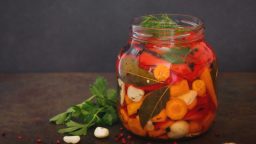Fermenting vegetables grown in your garden accomplishes two things at once. First, it enhances the nutritional value of the vegetables by preserving them at their peak. Second, it preserves the vegetables, so you can enjoy them all winter long.
The process used for fermenting vegetables is simple. You need the right equipment and the right ingredients – and before you know it, you’ll have a pantry full of delicious, fermented vegetables for your family to eat.
Fermentation Equipment
The equipment you need to ferment vegetables is minimal and inexpensive. Here are the basic things you’ll need to have on hand:
- Jars or containers to put the vegetables and pickling brine in
- A sharp knife and cutting board for preparing the vegetables
- Airlock tops (we like ones that are compatible with Mason jars) to keep oxygen out of the jars
- A pickle packer (usually a wooden stick used to pack the prepared vegetables into the jar)
- Weights to weigh down the vegetables
You can buy these items individually or in fermentation packages. Here is an easy, complete Fermentation Kit from Amazon you can try.
Fermentation Ingredients
The ingredients you need to ferment vegetables depend on the method you plan to use. However, there are only a few variations you need to know about. Here’s what you’ll need:
- Fresh vegetables from your garden
- Salt, whey, or a starter culture
- Water
There are many types of salt, but some are better suited to fermentation than others. Two of our favorites are sea salt and Himalayan pink salt. Both add a nice flavor. You can also buy pickling salt although it’s not the best choice if you want a natural, minimally-processed salt.
The water you choose for pickling can make a big difference in the final product. If you use tap water, you should boil it or run it through a reverse-osmosis filter for the best results. Well water often has a high mineral content. That can be good for some kinds of fermentation but it’s not particularly good for some fermented products like kombucha.
How to Prepare the Vegetables
The method you use to prepare your vegetables for fermentation depends on what you’ll be preserving. Some vegetables, such as cabbage, ferment most effectively when they are shredded. Others, like cherry tomatoes, can be fermented whole.
It may take some trial and error to arrive at the proper preparation. You may want to start by fermenting just one type of vegetable. Later, you can mix vegetables to create pickled salads that are ready to eat out of the jar.
The Pickling Process
The next step is after you have prepared the vegetables is to place them in the jars, cover them with brine, and weight them so they can ferment properly.
You want to use weights on top of the vegetables, so they stay submerged in the brine. That’s a very important step that some first-time fermenters skip.
There’s an art to knowing when vegetables are done with fermentation. You’ll have to rely on the specific recipes you use to be sure when they’re done. They need to be kept in an anaerobic environment (air free) while they ferment.
When they are ready, you’ll be able to remove the weights, seal the jars, and put them in cold storage. Prepared properly, fermented vegetables will keep for months.
Wondering What to Make?
If you’re wondering where to start, here are some suggestions for easy fermentation:
- White or red cabbage (sauerkraut)
- Kimchi (spicy Korean cabbage)
- Pickled green beans
- Pickled tomatoes
- Fermented carrot sticks or slices
Do you have a favorite recipe for fermented vegetables? Tell us about it in the comments!




